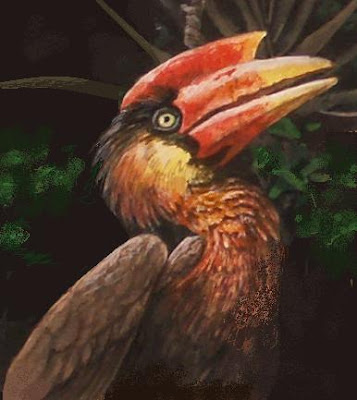AN OBSERVATION OF THROAT-PATCH DISPLAYING IN MALE POORWILLS
On May 30, 2015 I was hiking in the Wasatch Mountains in Salt Lake County, Utah, just after dark at a elevation of about 7,000 feet, when I observed two
Poorwills (Phalaenoptilus nuttallii)
perched about half a meter apart on the ground. I watched the two birds
in my headlamp beam through binoculars from a distance of about 10
meters. After some 30 seconds, bird B fluttered into the air briefly and
landed, increasing its distance from bird A by about two meters. Ten or
fifteen seconds later, bird A flew towards bird B, restoring the
distance between the birds to roughly what it was before. About 45
seconds later, bird B flew away. some 10 seconds later, bird A also took
off in the same direction. It wasn't until the next morning, when I
looked at the photographs I took of the birds, that I was able to tell
that both birds were males. In the photographs where both birds were
perched close together, they were both clearly flaring their white
throat patches and displaying them. Bird B also appeared to be spreading
its tail, displaying the white patches there. Bird A's tail was
obscured in these photos. I inferred this interaction to be a
territorial rivalry, but the actual nature of the display is not clear. I
was unable to discern any other behavior such as head-bobbing, but
viewing conditions were far from ideal.
I have not seen nor heard of Poorwills displaying in this manner. I sent this photograph to R. Mark Brigham, a Poorwill expert at the University of Regina, who told me he had never seen Poorwills do this either.
 These birds are very interesting for a number of reasons, most famously for their manner of surviving winter's
cold temperatures and lack of food
resources. Hibernation is a common way for animals to deal with winter.
Many birds, bats and even insects opt instead for seasonal
migration, exploiting distant habitats during different seasons. A few,
like the Monarch Butterfly (Danaus plexippus)
and our friend the Poorwill use a combination of the
two. Poorwills, relatives of Nightjars, breed in arid parts of western
North America from southern Canada into northern Mexico; northern
individuals seem to winter in the desert southwest. A number of bird
species use daily torpor to minimize energy loss during cool nights or
brief bad weather. Members of three related orders, the goatsuckers,
hummingbirds and possibly the swifts, all show some abilities at
metabolic adjustment, but none to the degree of the little Poorwill,
which, in addition to its natural tendencies toward torpor, feeds
heavily on beetles, rich in polyunsaturated fats, which remain liquid
and metabolically
These birds are very interesting for a number of reasons, most famously for their manner of surviving winter's
cold temperatures and lack of food
resources. Hibernation is a common way for animals to deal with winter.
Many birds, bats and even insects opt instead for seasonal
migration, exploiting distant habitats during different seasons. A few,
like the Monarch Butterfly (Danaus plexippus)
and our friend the Poorwill use a combination of the
two. Poorwills, relatives of Nightjars, breed in arid parts of western
North America from southern Canada into northern Mexico; northern
individuals seem to winter in the desert southwest. A number of bird
species use daily torpor to minimize energy loss during cool nights or
brief bad weather. Members of three related orders, the goatsuckers,
hummingbirds and possibly the swifts, all show some abilities at
metabolic adjustment, but none to the degree of the little Poorwill,
which, in addition to its natural tendencies toward torpor, feeds
heavily on beetles, rich in polyunsaturated fats, which remain liquid
and metabolically
available at low temperatures.I've watched Poorwills feed on darkling beetles on the ground, and have noticed that medium-sized ground beetles are usually common where there is a dense population of Poorwills.In the laboratory, these birds have been observed sustaining periods of torpor for over 80 days, and in the wild as long as 25 days. A shallow shelter, open to the southern sun is selected: a patch of cactus or rock niche to which the bird develops substantial fidelity. After sundown, the torpid Poorwill's body temperature begins to fall, until the ambient temperature reaches 5.5°C, an apparent optimum hibernating level which the bird tries to maintain. Solar radiation raises the body temperature daily, presumably allowing the option to forage during warm nights. I know of no human witnesses to a Poorwill rousing from torpor in the wild, but I imagine the bird backing out of his shelter to fully bask in the final evening rays, periodically flapping his wings to elevate his body temperature. It's not known how severe a winter these birds can survive, but a sufficient winter insect population, rather than temperature, is probably the limiting factor.
_____________________
illustrations:
(top): Photo by cpbvk
(center): Poorwill field sketch; pencil 11" x 8.5"
(lower): REANIMATION: POORWILL (2012) acrylic 30" x 20"







